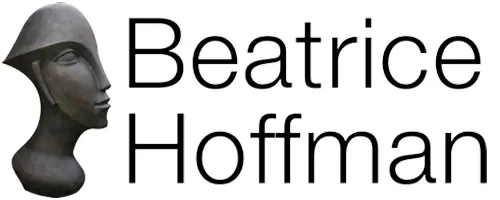Understanding abstract sculptures
Abstract sculpture represents a bold, modern approach to art – one that celebrates form, material, and creativity over literal representation. For many, abstract sculptures offer a unique way to engage with art, inviting interpretation, imagination, and personal connection. Unlike figurative works, which rely on recognisable subjects, abstract sculptures encourage viewers to explore their own intuition and emotional response, making each encounter with the piece entirely personal.

Abstract Wave 2 in colour interplay with a Hoytsia bush
The evolution of abstract sculptures
The rise of abstract sculpture is closely linked to the history of art itself. In the mid-19th century, photography transformed the way we see the world. Realistic depiction no longer fell solely to painters and sculptors, freeing them to experiment with the language of art itself. Early 20th-century artists like Wassily Kandinsky and Piet Mondrian moved from representational to abstract painting, exploring composition, colour, line, and tone without the need for objects to be immediately recognisable. Sculptors followed a similar journey, embracing abstraction to explore pure form, material, and spatial relationships.
This freedom allowed artists to focus on elements such as:
- Scale and proportion: varying sizes of different components to create balance or tension
- Line and outline: creating movement, rhythm, or structure
- Surface texture: rough, smooth, convex, concave, or tactile
- Tone: light and shadow interacting across shapes
- Material and colour: expanding beyond traditional clay, stone, wood, and bronze to include steel, plastics, and vivid, unconventional hues.
Some abstract sculptures are entirely non-representational, while others reinterpret familiar forms – natural objects like shells, fruits, or trees, or even the human figure – in a simplified or inventive way. Rather than depicting reality, these works aim to capture the essence or spirit of a subject.

Big Claw, shown at single show at Cheseltine Gallery 2016
Pioneers of abstract sculptures
Key figures in the development of abstract sculpture include:
- Konstantin Brancusi: explored ‘pure’ forms derived from reality, such as a bird or a human head
- Henry Moore: merged organic natural forms with the human figure
- Barbara Hepworth: simplified geometric and organic shapes, often exploring negative space
- Alexander Calder: created kinetic sculptures and mobiles
- David Smith and Anthony Caro: focused on steel, geometric abstraction, and the interplay of form and space
Their innovations established abstraction as a versatile and expressive language, one that continues to influence contemporary sculpture.
The appeal of abstract sculptures for collectors
For collectors, abstract sculptures provide an opportunity for deeper engagement and personal interpretation. Unlike figurative works, where meaning is often obvious, abstract pieces invite the viewer to explore, imagine, and respond freely. And, as a result, each person can find their own story or emotional resonance within a sculpture.
My own sculptures reflect this philosophy. They span a continuum from representational to abstract, often exploring geometric, organic, and inventive forms. Some key themes in my work include:
- Geometric forms: circles and spheres are central in pieces like ‘Abstract Wave 2’ and Sphere, where positive shapes and negative spaces interact to create dynamic tension.
- Tool-inspired shapes: works such as ‘Claw Form’ draw on geometric motifs found in everyday objects.
- Organic forms: sculptures like ‘Fruits on Trunk’ reimagine natural forms, presenting two or three fruits on a branch in a stylised, abstracted way.
- Human figures and heads: I simplify, omit, or combine elements to highlight essential forms. For example, in ‘Standing Together’ and ‘Family Group’, limbs are reduced to focus on connection and expression. Pieces like ‘Trumpet Woman’ blend the figure with geometric shapes, creating an original dialogue between form and concept.
- Inventive abstractions: Works such as ‘Sun and Moon’ and ‘Mother and Child 2’ merge multiple faces or heads into a single form, exploring relationships and dualities.
Some sculptures also use exaggeration to evoke ancient archetypes, such as wide hips and slim waists in ‘First Woman’, or pronounced upper arms in ‘Little Venus’, emphasising sensuous round forms.

Family Group shown against the lakes of the sculpture park “Sculpture by the lakes”
Choosing an abstract sculpture
When selecting an abstract sculpture for your collection, consider what attracts you to that specific piece of art – whether it’s shape, colour, texture, or the story it conveys. Each piece is designed to inspire imagination and reflection. Buying an abstract sculpture is more than simply acquiring an object, it’s embracing creativity, originality, and the enduring beauty of form.
Are you looking to buy an abstract sculpture?
If you’re considering buying an abstract sculpture, then please take a look at some of my work. In addition to the sculptures you find on my website, I also offer a bespoke service. If you would like to hear more, please get in touch.
